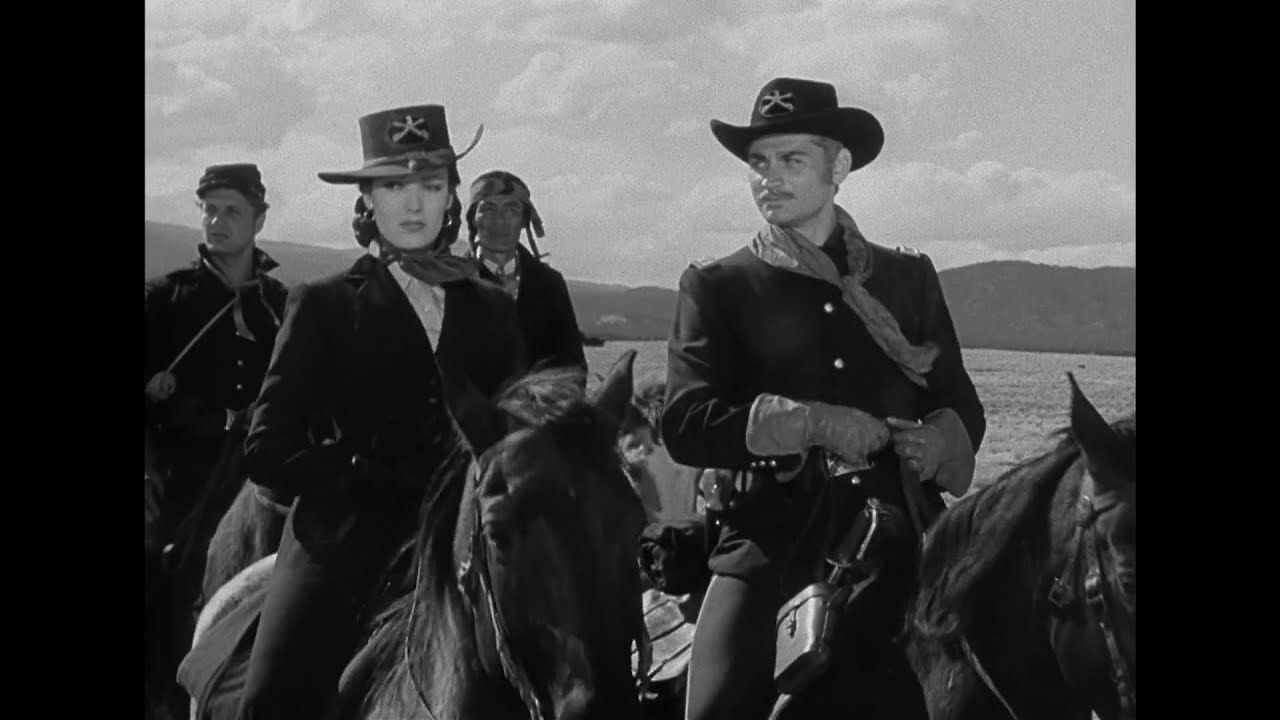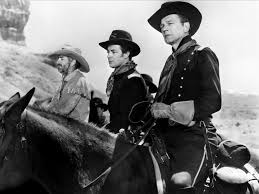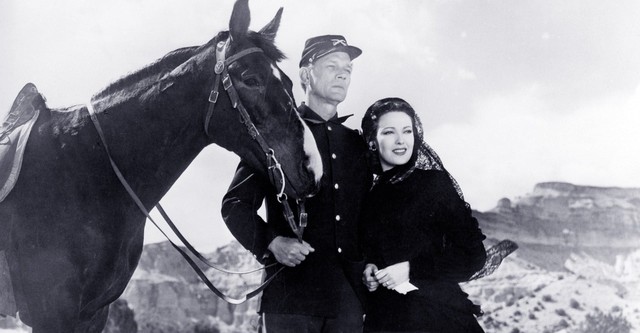🎬 Two Flags West (1950)

Two Flags West (1950) Review: A Unique Blend of War, Loyalty, and Frontier Drama
Directed by Robert Wise, Two Flags West is a compelling Western set during the American Civil War that intertwines themes of duty, loyalty, and personal conflict. Featuring a strong cast led by Joseph Cotten, Linda Darnell, and Jeff Chandler, the film offers a gripping narrative that stands apart from conventional Westerns by incorporating the complexities of war and the moral dilemmas it creates. With its rich storytelling and nuanced characters, Two Flags West is a thought-provoking exploration of the blurred lines between enemies and allies.
Plot Overview: The Civil War Comes to the Frontier
The story begins in 1863 with a group of Confederate prisoners of war offered a choice: remain in a Union prison camp or join the Union Army to fight Native American tribes on the western frontier. Among those who accept is Colonel Clay Tucker (Joseph Cotten), a Southern gentleman with a deep sense of honor and loyalty to his men.
Tucker and his soldiers are sent to Fort Thorn in New Mexico Territory, where tensions immediately rise with the Union troops stationed there. Major Henry Kenniston (Jeff Chandler), the fort’s commanding officer, harbors resentment toward Tucker and his men, viewing them with suspicion and disdain. The fort’s only woman, Elena Kenniston (Linda Darnell), Henry’s widowed sister-in-law, adds emotional complexity as she forms a bond with Tucker.
As Native American attacks and internal conflicts escalate, the soldiers are forced to confront their prejudices and personal loyalties, leading to a dramatic and tragic conclusion.
Joseph Cotten as Colonel Clay Tucker: A Stoic and Charismatic Leader
Joseph Cotten delivers a nuanced performance as Colonel Tucker, portraying him as a man of honor torn between his loyalty to the Confederacy and his sense of duty as a soldier. Cotten’s charisma and subtlety anchor the film, allowing Tucker’s internal conflicts to resonate with the audience. His interactions with Linda Darnell’s Elena add emotional depth, while his leadership in moments of crisis underscores his strength of character.
Jeff Chandler as Major Henry Kenniston: A Complex Antagonist
Jeff Chandler brings intensity and gravitas to the role of Major Kenniston, a Union officer whose bitterness and rigidity mask his underlying vulnerabilities. Chandler’s performance effectively conveys Kenniston’s struggle to reconcile his duty with his personal biases, making him a multidimensional and compelling character rather than a one-dimensional antagonist.
Linda Darnell as Elena Kenniston: A Symbol of Compassion and Resilience
Linda Darnell’s portrayal of Elena adds warmth and emotional complexity to the film. As a Southern widow living in a Union fort, Elena embodies the film’s central theme of divided loyalties. Her growing connection with Tucker highlights the personal cost of war, while her strength and compassion serve as a counterpoint to the hostility and violence around her.
Supporting Cast: A Strong Ensemble
- Cornel Wilde as Captain Mark Bradford: Wilde plays a Union officer caught between his respect for Tucker and his loyalty to Major Kenniston, adding another layer of tension to the story.
- Jay C. Flippen as Sergeant Terrance: Flippen provides moments of levity and camaraderie, balancing the film’s heavier themes.
- Noah Beery Jr. as Ephraim Strong: As one of Tucker’s loyal Confederate soldiers, Beery adds authenticity to the portrayal of the Southern contingent.

Themes: Loyalty, Conflict, and the Cost of War
- Loyalty and Betrayal: The film examines the shifting allegiances and moral dilemmas faced by soldiers on both sides of the Civil War, emphasizing the complexity of loyalty during wartime.
- Humanizing the Enemy: By focusing on Confederate soldiers serving in a Union fort, the film challenges traditional notions of “enemy” and “ally.”
- The Toll of War: The narrative highlights the emotional and physical toll of war on individuals, families, and communities, making it a deeply human story.
Direction and Cinematography: A Masterful Blend of Atmosphere and Action
Robert Wise’s direction is meticulous, balancing tense action sequences with intimate character moments. The cinematography by Leon Shamroy captures the stark beauty of the New Mexico Territory, using wide landscapes and claustrophobic interiors to reflect the characters’ external and internal struggles. The battle scenes are skillfully staged, emphasizing the chaos and brutality of frontier warfare.
Key Moments That Define Two Flags West
- The Arrival at Fort Thorn: Tucker and his men’s tense introduction to the Union soldiers sets the tone for the film’s exploration of distrust and prejudice.
- The Siege: A thrilling and harrowing sequence where the fort is attacked by Native American warriors, forcing the characters to put aside their differences and work together.
- The Climactic Confrontation: The film’s emotional finale delivers a poignant commentary on the futility of war and the sacrifices it demands.
Strengths of Two Flags West
- Complex Characters: The film’s protagonists and antagonists are richly developed, making their conflicts and alliances feel authentic and compelling.
- Tense Atmosphere: The constant threat of violence and internal discord keeps the narrative engaging and suspenseful.
- Strong Performances: Cotten, Chandler, and Darnell lead a talented cast, bringing depth and nuance to their roles.
- Thoughtful Themes: The film’s exploration of loyalty, morality, and human connection elevates it above many traditional Westerns.
Weaknesses of Two Flags West
- Simplistic Portrayals of Native Americans: As with many Westerns of its time, the film presents Native Americans primarily as antagonistic forces, lacking depth or nuance in their portrayal.
- Deliberate Pacing: While the slower pace allows for character development, some viewers may find it detracts from the film’s overall tension.
- Underexplored Relationships: Certain character dynamics, particularly between Tucker and Elena, could have been given more screen time to fully develop.

Legacy and Reception
Two Flags West was well-received for its strong performances and unique take on the Western genre, though it did not achieve the commercial success of other films of its era. Over time, it has gained recognition as an underrated gem, appreciated for its thoughtful storytelling and nuanced exploration of Civil War-era conflicts.
Fun Facts About Two Flags West
- Historical Basis: The concept of Confederate prisoners serving in Union regiments is inspired by historical events, adding authenticity to the film’s premise.
- Linda Darnell’s Versatility: Known for her roles in romantic dramas, Darnell’s performance here demonstrates her range as an actress.
- Robert Wise’s Direction: Two Flags West is one of several genre-defining films directed by Wise, who would later helm classics like The Day the Earth Stood Still (1951) and The Sound of Music (1965).
Conclusion: A Thoughtful and Underrated Western
Two Flags West (1950) is a compelling and layered film that transcends its Western trappings to explore the moral and emotional complexities of war. With strong performances, a unique narrative, and stunning cinematography, it stands as a thought-provoking entry in the genre. Though not without its flaws, its themes of loyalty, conflict, and human connection ensure its enduring relevance and appeal to fans of historical dramas and character-driven storytelling.